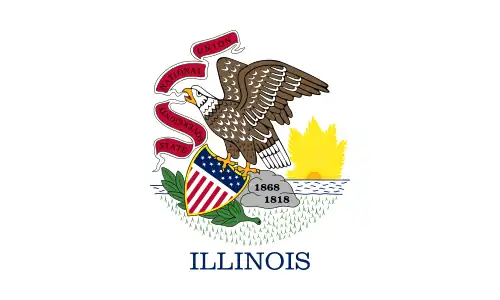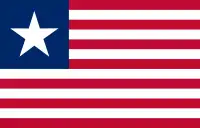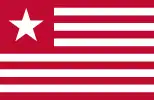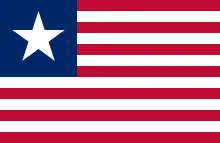
The flags of the U.S. states, territories, and the District of Columbia (Washington, D.C.) exhibit a variety of regional influences and local histories, as well as different styles and design principles. Modern U.S. state flags date from the turn of the 20th century, when states considered distinctive symbols for the 1893 World's Columbian Exposition in Chicago, Illinois. Most U.S. state flags were designed and adopted between 1893 and World War I.[1]
The most recently adopted state flag is that of Minnesota, adopted on December 19, 2023; while the most recently adopted territorial flag is that of the Northern Mariana Islands, adopted on July 1, 1985. The flag of the District of Columbia was adopted in 1938. Recent legislation in Massachusetts (2021) has started the process of redesigning their state flag.
Despite a variety of designs, the majority of the states' flags share the same design pattern consisting of the state seal superimposed on a monochrome background, commonly a shade of blue, which remains a source of criticism from vexillologists. According to a 2001 survey by the North American Vexillological Association, New Mexico has the best-designed flag of any U.S. state, U.S. territory, or Canadian province, while Georgia's state flag was rated the worst (the latter of which has been changed since the survey was conducted).[2]
Current state flags
Listed alphabetically with their respective date of adoption.

Flag of Alabama
(February 16, 1895)[3]
Flag of Alaska
(May 2, 1927)
Flag of Arizona
(February 27, 1917)
Flag of Arkansas
(February 28, 2011)
Flag of California
(February 3, 1911)
Flag of Colorado
(June 5, 1911)
Flag of Connecticut
(September 9, 1897)
Flag of Delaware
(July 24, 1913)
Flag of Florida
(November 6, 1900)
Flag of Georgia
(February 19, 2003)
Flag of Hawaii
(December 29, 1845)
Flag of Idaho
(March 12, 1907)
Flag of Illinois
(September 17, 1969)
Flag of Indiana
(May 11, 1917)
Flag of Iowa
(March 29, 1921)
Flag of Kansas
(September 24, 1961)
Flag of Kentucky
(March 26, 1918)
Flag of Louisiana
(November 22, 2010)[4]
Flag of Maine
(February 23, 1909)
Flag of Maryland
(March 9, 1904)
Flag of Massachusetts
(July 3, 1971)
Flag of Michigan
(August 1, 1914)
Flag of Minnesota
(August 2, 1983)
Flag of Mississippi
(January 11, 2021)[5][6]
Flag of Missouri
(March 22, 1913)
Flag of Montana
(July 1, 1981)
Flag of Nebraska
(July 16, 1963)
Flag of Nevada
(July 25, 1991)
Flag of New Hampshire
(1931)
Flag of New Jersey
(May 11, 1896)[lower-alpha 1]
Flag of New Mexico
(March 15, 1925)
Flag of New York
(April 2, 1901)[lower-alpha 2]
Flag of North Carolina
(March 9, 1885) (June 24, 1991)[7]
Flag of North Dakota
(March 11, 1911)
Flag of Ohio
(May 9, 1902)
Flag of Oklahoma
(April 2, 1925; formally November 1, 2006)[8][9]
Flag of Oregon (obverse)
(April 15, 1925)[10][11].svg.png.webp)
Flag of Oregon (reverse)[10]

Flag of Pennsylvania
(June 13, 1907)
Flag of Rhode Island
(November 1, 1897)
Flag of South Carolina
(January 26, 1861)
Flag of South Dakota
(November 9, 1992)
Flag of Tennessee
(April 17, 1905)
Flag of Texas
(January 25, 1839)[lower-alpha 3]
Flag of Utah
(1913 and February 16, 2011)[lower-alpha 4]
Flag of Vermont
(June 1, 1923)
Flag of Virginia
(March 28, 1912) (February 1, 1950)[13]
Flag of Washington
(March 5, 1923)[14]
Flag of West Virginia
(March 7, 1929)
Flag of Wisconsin
(May 1, 1981)[15]
Flag of Wyoming
(January 31, 1917)
Current federal district flag
This is the current flag of the District of Columbia.
Current territory flags
These are the current official flags of the five permanently inhabited territories of the United States. Dates in parentheses denote when the territory's current flag was adopted by its respective political body.
 Flag of American Samoa
Flag of American Samoa
(April 17, 1960) Flag of Guam
Flag of Guam
(February 9, 1948) Flag of the Northern Mariana Islands
Flag of the Northern Mariana Islands
(July, 1985) Flag of Puerto Rico
Flag of Puerto Rico
(1952) Flag of the U.S. Virgin Islands
Flag of the U.S. Virgin Islands
(May 17, 1921)
Current state ensigns
Maine and Massachusetts have ensigns for use at sea.
Commemorative state flags
Future state flags
.svg.png.webp)
Flag of Minnesota
(to go into effect on May 11, 2024)[16]
Flag of Utah
(to go into effect on March 9, 2024)[17]
Historical state and territory flags
Former state flags
 Flag of Alaska
Flag of Alaska
(October 10, 1806 – October 18, 1867).svg.png.webp) Flag of Arkansas
Flag of Arkansas
(February 26, 1913–1923).svg.png.webp) Flag of Arkansas
Flag of Arkansas
(1923–1924).svg.png.webp) Flag of Arkansas
Flag of Arkansas
(1924–2011).svg.png.webp) Flag of Colorado
Flag of Colorado
(1876 – 1907).svg.png.webp) Flag of Colorado
Flag of Colorado
(1907 – December 4, 1911).svg.png.webp) Flag of Colorado
Flag of Colorado
(December 4, 1911 – March 31, 1964).svg.png.webp)
.svg.png.webp) Flag of Florida
Flag of Florida
(November 1900 – May 1985)[18].svg.png.webp)
.svg.png.webp) Flag of Georgia
Flag of Georgia
(1879–1902).svg.png.webp) Flag of Georgia
Flag of Georgia
(1902–1906).svg.png.webp) Flag of Georgia
Flag of Georgia
(1906–1920).svg.png.webp) Flag of Georgia
Flag of Georgia
(1920–1956).svg.png.webp) Flag of Georgia
Flag of Georgia
(1956–2001).svg.png.webp) Flag of Georgia
Flag of Georgia
(2001–2003).svg.png.webp) Flag of Illinois
Flag of Illinois
(1915–1969).png.webp)
.gif) Flag of Iowa
Flag of Iowa
(1917–1921) Proposed flag of Kansas
Proposed flag of Kansas
(1916–1917).svg.png.webp) Flag of Kansas
Flag of Kansas
(1927 – September 24, 1961).svg.png.webp) Flag of Kentucky
Flag of Kentucky
(March 26, 1918–1963).svg.png.webp) Flag of Louisiana
Flag of Louisiana
(February 1861–1912)[20].svg.png.webp) Flag of Louisiana
Flag of Louisiana
(1912 – May 7, 2006).svg.png.webp) Flag of Louisiana
Flag of Louisiana
(May 7, 2006 – November 22, 2010).png.webp) Flag of Maryland
Flag of Maryland
(pre-1904)
.svg.png.webp) Flag of Massachusetts
Flag of Massachusetts
(reverse, 1908–1971).svg.png.webp) Flag of Maine
Flag of Maine
(1901–1909).svg.png.webp) Flag of Minnesota
Flag of Minnesota
(January – February 28, 1893).svg.png.webp) Flag of Minnesota
Flag of Minnesota
(obverse, February 28, 1893 – August 1957).svg.png.webp) Flag of Minnesota
Flag of Minnesota
(reverse, February 28, 1893 – August 1957).svg.png.webp) Flag of Minnesota
Flag of Minnesota
(August 1957 – August 1983).svg.png.webp) Flag of Mississippi
Flag of Mississippi
(March 30, 1861 – August 22, 1865).svg.png.webp) Flag of Mississippi
Flag of Mississippi
(April 23, 1894 – 1996).svg.png.webp) Flag of Mississippi
Flag of Mississippi
(1996 – February 7, 2001).svg.png.webp) Flag of Mississippi
Flag of Mississippi
(2001 – June 30, 2020) Provisional Flag of Mississippi
Provisional Flag of Mississippi
(2020 – 2021).svg.png.webp) Flag of Montana
Flag of Montana
(1905 – July 1, 1981).png.webp) Flag of Nebraska
Flag of Nebraska
(1917 – April 2, 1925, unofficial).png.webp) Flag of New Hampshire
Flag of New Hampshire
(1909 – November 30, 1931).png.webp)
.svg.png.webp)
.svg.png.webp) Flag of New York
Flag of New York
(1778 – April 2, 1901).svg.png.webp) Flag of New York (April 2, 1901 – 2020)
Flag of New York (April 2, 1901 – 2020).svg.png.webp) Flag of Nevada
Flag of Nevada
(July 20, 1905–1915).png.webp) Flag of Nevada
Flag of Nevada
(1915–1929).svg.png.webp) Flag of Nevada
Flag of Nevada
(1929 – July 25, 1991).svg.png.webp) Flag of North Carolina
Flag of North Carolina
(March 1885 – June 24, 1991).svg.png.webp) Flag of Oklahoma
Flag of Oklahoma
(1911–1925).svg.png.webp) Flag of Oklahoma
Flag of Oklahoma
(1925–1941).svg.png.webp) Flag of Oklahoma
Flag of Oklahoma
(1941–1988).svg.png.webp) Flag of Oklahoma
Flag of Oklahoma
(1988–2006).gif) Flag of Oregon
Flag of Oregon
(1900–1925) Flag of Pennsylvania
Flag of Pennsylvania
(1778–1909).svg.png.webp) Flag of Rhode Island
Flag of Rhode Island
(1877–1882).svg.png.webp) Flag of Rhode Island
Flag of Rhode Island
(1882–1897) Flag of South Carolina
Flag of South Carolina
(1775 – January 26, 1861).svg.png.webp) Flag of South Carolina
Flag of South Carolina
(January 26 – January 28, 1861).svg.png.webp) Flag of South Dakota
Flag of South Dakota
(1909–1963).svg.png.webp) Flag of South Dakota
Flag of South Dakota
(1963–1992).svg.png.webp) Flag of Tennessee
Flag of Tennessee
(1861, unofficial).svg.png.webp) Flag of Tennessee
Flag of Tennessee
(1897 – April 17, 1905).svg.png.webp) Flag of Texas
Flag of Texas
(1839 – 1879) Flag of Utah
Flag of Utah
(1850? – March 1903).svg.png.webp) Flag of Utah
Flag of Utah
(March 1903–1922)[lower-alpha 4].svg.png.webp) Flag of Utah
Flag of Utah
(1922–February 16, 2011)[lower-alpha 4] Flag of Vermont
Flag of Vermont
(June 1, 1770 – June 13, 1804).svg.png.webp) Flag of Vermont
Flag of Vermont
(June 14, 1804 – April 3, 1837).svg.png.webp) Flag of Vermont
Flag of Vermont
(April 6, 1837 – April 16, 1923).svg.png.webp) Flag of Washington
Flag of Washington
(March 5, 1923–1967).svg.png.webp) Flag of West Virginia
Flag of West Virginia
(1905–1907).png.webp) Flag of West Virginia
Flag of West Virginia
(1907–1929).png.webp) Flag of Wisconsin
Flag of Wisconsin
(1866–1913).svg.png.webp) Flag of Wisconsin (1913–1981)
Flag of Wisconsin (1913–1981)
Former territory flags
.svg.png.webp) Former Northern Mariana Islands flag (1970s)
Former Northern Mariana Islands flag (1970s).svg.png.webp) Former Northern Mariana Islands flag (1980s)
Former Northern Mariana Islands flag (1980s).svg.png.webp) Original flag of Puerto Rico (1895–1952)
Original flag of Puerto Rico (1895–1952)
American Civil War
.svg.png.webp)
.svg.png.webp)
 Flag of Florida
Flag of Florida
(September 27, 1861, unofficial).gif) Flag of Mississippi
Flag of Mississippi
(March 30, 1861 – August 22, 1865).svg.png.webp) Flag of North Carolina
Flag of North Carolina
(March 16, 1861 – March 1, 1885).svg.png.webp) Flag of Virginia
Flag of Virginia
(1861 – 1865)
Pre-Texan Revolution
 Flag of the Gutiérrez–Magee Expedition
Flag of the Gutiérrez–Magee Expedition Flag of the Long Expedition (1819–1821)
Flag of the Long Expedition (1819–1821) Flag of the Long Expedition (1821)
Flag of the Long Expedition (1821) Fredonian Rebellion Flag
Fredonian Rebellion Flag
Texan Revolution
.svg.png.webp) Flag of the Republic of Texas (June 10, 1836 – June 29, 1839)
Flag of the Republic of Texas (June 10, 1836 – June 29, 1839)
.svg.png.webp) Texas Lone Star and Stripes
Texas Lone Star and Stripes The Dodson Flag
The Dodson Flag The Alamo Flag
The Alamo Flag The Ensign of the First Texas Navy (1836–38)
The Ensign of the First Texas Navy (1836–38)
California Republic
.svg.png.webp) California Lone Star Flag 1836
California Lone Star Flag 1836 Digital reproduction of Peter Storm's original 1846 Bear Flag
Digital reproduction of Peter Storm's original 1846 Bear Flag.svg.png.webp) Digital reproduction of Todd's Bear Flag
Digital reproduction of Todd's Bear Flag
Other
Native American flags
Many Native American nations have tribal sovereignty, with jurisdiction over their members and reserved land. Although reservations are on state land, the laws of the state(s) do not necessarily apply.[25] Below are the flags of some of the largest Indian tribes reservations by population and area:


 Flag of the Osage Nation
Flag of the Osage Nation Flag of the Puyallup Indian Reservation
Flag of the Puyallup Indian Reservation flag of the Flathead Indian Reservation
flag of the Flathead Indian Reservation Flag of the Northern Arapaho of the Wind River Indian Reservation
Flag of the Northern Arapaho of the Wind River Indian Reservation Flag of the Saginaw Chippewa Tribal Nation of the Isabella Indian Reservation
Flag of the Saginaw Chippewa Tribal Nation of the Isabella Indian Reservation Flag of the Uintah and Ouray Indian Reservation
Flag of the Uintah and Ouray Indian Reservation Flag of the Oneida Nation of Wisconsin
Flag of the Oneida Nation of Wisconsin Flag of the Pine Ridge Reservation
Flag of the Pine Ridge Reservation Flag of the Nez Perce
Flag of the Nez Perce Flag of the Tohono Oʼodham Nation
Flag of the Tohono Oʼodham Nation
 Flag of the Blackfeet Nation
Flag of the Blackfeet Nation
Unofficial flags of atolls, reefs, and other islands
The U.S. national flag is the official flag for all islands, atolls, and reefs composing the United States Minor Outlying Islands. However, unofficial flags are sometimes used to represent some of the insular areas in the U.S. Minor Outlying Islands:
See also
- Flag of the United States
- Flags of governors of the U.S. states
- List of flags of the United States (including county, city and historical flags)
- List of U.S. state, district, and territorial insignia
- Flags of the Confederate States
Notes
- ↑ Current variant adopted in 1965.
- ↑ Current variant adopted in 2020.
- ↑ Current variant adopted in 1879, officially used since 1933.
- 1 2 3 The current Utah design was formally adopted in 1913, slightly modifying a 1911 definition which in turn modified the unofficial 1903 flag. In practice, however, flags continued to use the 1903 design until 1922. In 1985 it was discovered that the post-1922 de facto standard did not match the 1913 definition; this persisted until 2011, when the legislature reaffirmed its 1913 definition and requested flag manufacturers to change it.[12]
References
- ↑ Artimovich, Nick. "Questions & Answers". North American Vexillological Association. p. 8. Archived from the original on April 17, 2007. Retrieved 2007-03-20.
- ↑ Kaye, Ted (2001-06-10). "New Mexico tops state/provincial flags survey, Georgia loses by wide margin". North American Vexillological Association. Archived from the original on October 19, 2013. Retrieved 2007-10-07.
- 1 2 3 "State Flag of Alabama". Alabama Emblems, Symbols and Honors. Alabama Department of Archives & History. 2006-04-27. Retrieved 2007-03-18.
- ↑ Anderson, Ed (November 22, 2010). "New Louisiana state flag with bleeding pelican is unfurled". The Times-Picayune. Archived from the original on November 24, 2010. Retrieved November 24, 2010.
- ↑ Ramseth, Luke (November 4, 2020). "Mississippi voters approve new magnolia design for state flag. Here's what happens next". clarionledger.com. Clarion Ledger. Retrieved 4 November 2020.
- ↑ "Mississippi Legislature 2020 Regular Session House Bill 1796". billstatus.ls.state.ms.us/. July 21, 2020. Retrieved 21 July 2020.
- ↑ "Official State Symbols of North Carolina". North Carolina State Library. State of North Carolina. Archived from the original on 2008-02-06. Retrieved 2008-01-26.
- ↑ "The Oklahoma State Flag". NetState. NState, LLC. February 6, 2014. Retrieved January 26, 2015.
Colors shall be colorfast and shall not bleed one into another. Added by Laws 1925, c. 234, p. 340, § 1. Amended by Laws 1941, p. 90, § 1; Laws 2006, c. 181, § 1, eff. Nov. 1, 2006.
- ↑ "Enrolled Senate Bill No. 1359". Oklahoma State Courts Network. May 23, 2006. Retrieved January 26, 2015.
This act shall become effective November 1, 2006.
- 1 2 "Oregon Almanac Topics - Dance to Hops - Flag, State". Retrieved 29 Jun 2020.
Oregon is the only state whose flag has different patterns on each side. The design for the Oregon flag was adopted by the legislature in 1925.
- ↑ Text states that Oregon adopted its flag in 1925
- ↑
- Hartvigsen, John M. (2011). "Utah's Adoption of Two Legislative Measures Affecting the Utah State Flag" (PDF). Proceedings of the 24th International Congress of Vexillology. North American Vexillological Association. pp. 391–406.
- "Utah State Flag Concurrent Resolution, 2011 General Session, State of Utah". Retrieved February 17, 2011.
- Dennis Romboy (9 March 2011). "Utahns celebrate first State Flag Day". KSL-TV. Retrieved 10 March 2011.
- ↑ Commonwealth of Virginia (February 1, 1950). "§ 1-506. Flag of the Commonwealth". Code of Virginia. Virginia: Commonwealth of Virginia. Retrieved January 28, 2015.
The flag of the Commonwealth shall be a deep blue field, with a circular white centre of the same material. Upon this circle shall be painted or embroidered, to show on both sides alike, the coat of arms of the Commonwealth, as described in § 1-500 for the obverse of the great seal of the Commonwealth; and there may be a white fringe on the outer edge, furthest from the flagstaff. This shall be known and respected as the flag of the Commonwealth. (Code 1950, § 7-32; 1966, c. 102, § 7.1-32; 2005, c. 839.)
- ↑ "Symbols of Washington State". Washington State Legislature. Archived from the original on 2007-03-05. Retrieved 2007-03-11.
- ↑ State of Wisconsin. "286". Section: 1.08: State flag. Retrieved August 21, 2015.
The department of administration shall ensure that all official state flags that are manufactured on or after May 1, 1981, conform to the requirements of this section. State flags manufactured before May 1, 1981, may continue to be used as state flags.
{{cite book}}:|work=ignored (help) - ↑ Albeck-Ripka, Livia (2023-12-19). "Minnesota Unveils New State Flag Design". The New York Times. Retrieved 2023-12-20.
- ↑ "SB0031". le.utah.gov. Retrieved 2023-12-20.
- 1 2 Florida Constitution Revision Commission (August 4, 2005). "Amendments, Election of 11-6-1900". The Florida State University. Archived from the original on October 8, 2014. Retrieved March 13, 2013.
- ↑ General Assembly of Indiana (1903). Legislative and State Manual of Indiana. W.B. Burford. Retrieved May 25, 2022.
- ↑ Archived 2014-08-12 at the Wayback Machine While this flag was officially adopted by Louisiana in 1861 there is no indication that it actually flew over state buildings up to 1912. In that year (1912) the blue pelican flag was officially adopted after nearly 100 years of unofficial use.
- ↑ "U.S. States L-M". WorldStatesmen.org. Retrieved May 23, 2022.
- ↑ 1896-specification flag
- ↑ New Mexico's First Flag (U.S.)
- ↑ New Mexico Flag Hasn't Always Had a Zia Symbol; Earliest Version Boasted Quartz Crystals, by Rick N athanson
- ↑ https://www.bia.gov/frequently-asked-questions BIA. U.S. Department of the Interior. Bureau of Indian Affairs. Frequently Asked Questions. Retrieved September 7, 2019.
- ↑ Klimeš, Roman (January 2000). "The Flag of Wake Island" (PDF). NAVA News. 33.
External links
- List of State Flags at State Symbols USA





.svg.png.webp)


.svg.png.webp)

.svg.png.webp)
